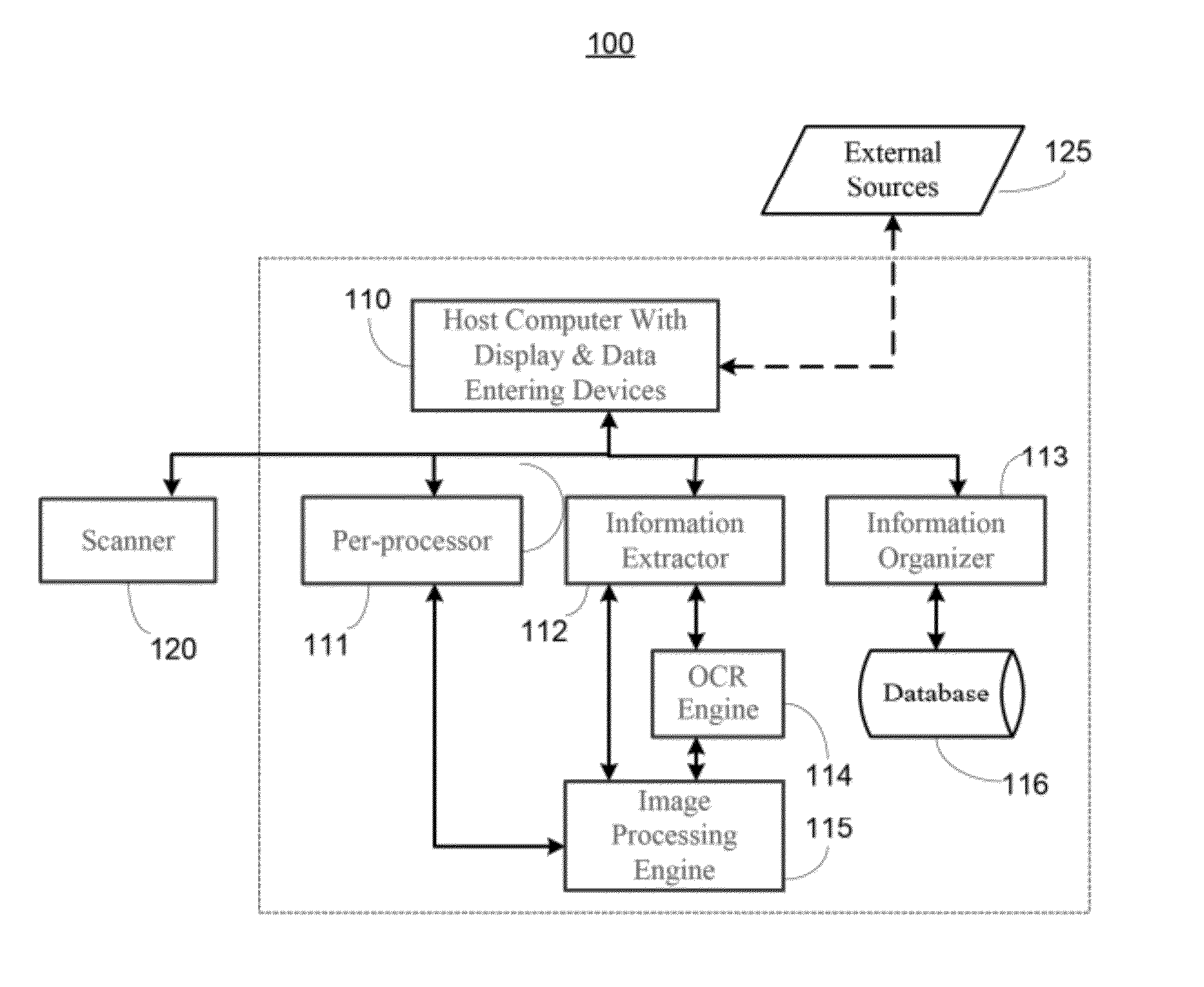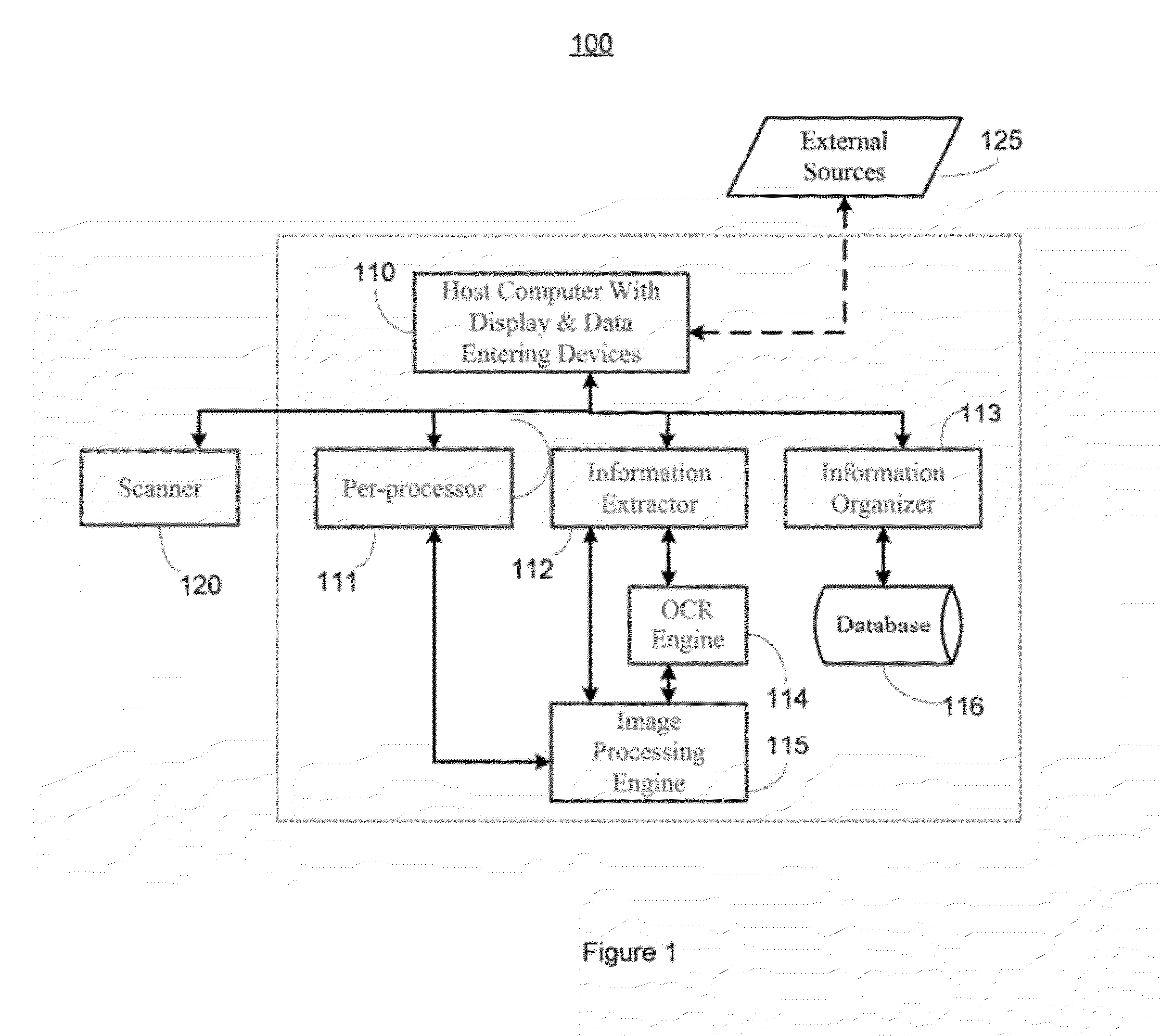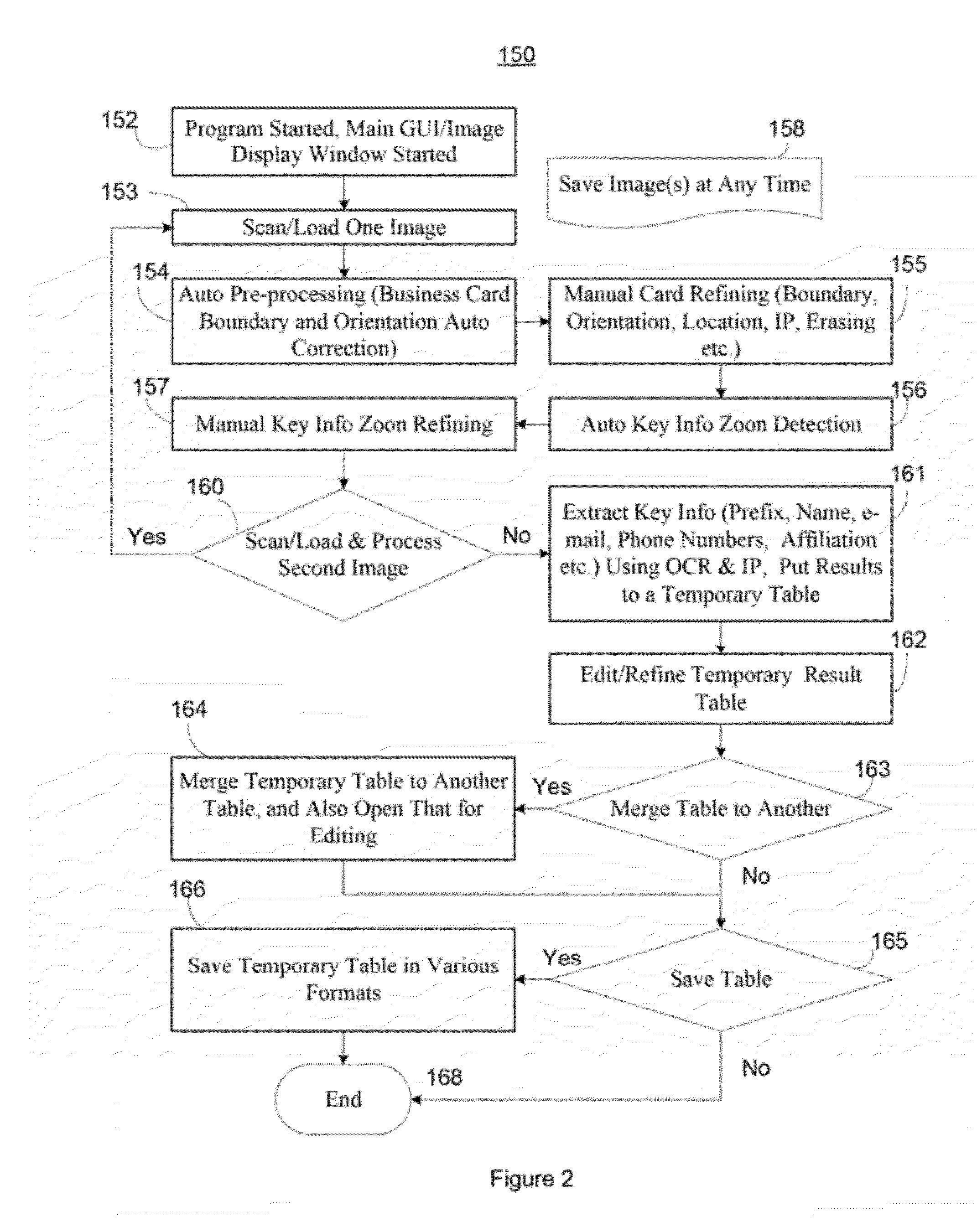[0005]In one aspect, the present invention relates to a system and a method for reading and managing business card information. In one embodiment of the invention, the system architecture as shown in FIG. 1 includes a
scanner, a host computer (used as the main
processing power with its
data input and output mechanism such as display screen, keyboard, and mouse), a preprocessing module for preprocessing cards such as detecting and refining card boundaries and orientation in the image, doing
image processing on cards, and detecting and refining key information areas in each card, an information extracting module for extracting key information items such as prefix, name, suffix,
email address, phone number,
mobile phone number,
fax number, address,
web site address etc. from key information areas, an
optical character recognition (OCR) engine used by information extracting module, an
image processing (IP) engine used by OCR engine and a preprocessing module for various image
processing tasks, an information organizing module for resulting business card
information management, and a
database system used by information organizing module and by the software on the computer as well. Also on the computer, there runs the main software for all business card information reading and result display and management applications, with its
graphical user interface (GUI), data structures, SW architecture, and algorithms governing the complete lifecycle of business card reading and managing. It also contains networking including
wireless networking power. Therefore, by using the invented method and system step by step, as shown in the
dataflow diagram in FIG. 2, the user can extract information of one or more business cards simultaneously and manage the extracted information properly for various business and personal purposes.
[0009]In one embodiment of the invention, one image, whether scanned or loaded from the computer's data storage media, can contain one or more business cards, partly due to the flexible system design in the invention. The card boundaries can be automatically detected by image processing algorithms in this invention e.g. by projecting the image in
horizontal and vertical directions, detecting their plateaus in both projections, back projecting the
plateau boundaries into image space, and using total counts to qualify candidate cards in image. Since automatic card finding method may not work all the time, it also allows the user to further manually modifying card boundaries, and add / delete cards to / from the
image display area, and to give / change card's ID (every detected business card in
image display area shall have a unique ID. Furthermore, to enhance the automatic card detection capability, the
scanner if it is an integrated part of the system, can be made to always provide dark background to help better detecting the card areas in the image. After finding cards in the image, it also does automatic card orientation detection and correction. Which can be done for example, by rotating the card in both directions in a set of small angles, then projecting the original image and the rotated image in horizontal / X direction or vertical / Y direction, finding the projection peak / maximum value at each
angle of rotation, and doing a
curve fitting to find the angle corresponding to the highest peak in the fitted curve. Since automatic angle detection does not always work perfectly and it is
time consuming, so the invention also allows the user to manually change the card orientation by rotating it around an axis which normally goes through the center of a card on the image. All cards in an image will be given a unique identification (ID), and the user can modify that too. To allow reading information from both sides of a card, the software (SW) designed for the invention allows the user to load a second image, i.e. to have one card in two images as front side and backside will have the same ID and the backside one will be further marked by an appendix, so that when their information is extracted, they can be put in one row for one card in the table which holds all card information extracted. When there are two pieces of conflicting information from two sides of a card, the one from the front side take the higher priority. For better detection and better keeping a card's information, it allows the user to do some image processing on selected cards (by
computer mouse) like
noise filtering,
histogram manipulation like brightness / contrast changing etc., and it allows the user to erase some of the unwanted pixels from the
card image, and allows the user to save the each card's image.
[0010]When each business card's boundary and orientation in the scanned image(s) have been detected and fixed, the software (SW) designed for this invention will first try to automatically identify key information areas, e.g. areas which contain prefix, name (first name, middle name or initial, last name), suffix,
email address, phone number,
mobile phone number,
fax number, affiliation, address,
web site URL, and even logo. The automatic key information detection can be done by searching key characters or character combinations such as “www”, “.com”, “.edu”, “.org”, and “@” sign using some OCR techniques. This automatic detection may not be perfect, so the SW in the invention provides for each business card a set of templates for all the selected key information items and their corresponding key information areas as rectangles / bounding box (over-layer drawings with a line connected between the bounding box and the name as text over-layer also), so that the user will only need to modify i.e. to resize, move, enable, disable the bounding boxes of the key information areas. Then it extracts information form all key information areas from all cards on the image(s) and put them into a temporary table, and allows the user to further modify the contents in the table. Finally it allows the user to merge the contents in the temporary table to another table whether it is in a saved file on the computer storage media or an opened table, and it allows the user to save the table. The saved business card information can be put into a
database on the computer, or simply in a
file system using
Microsoft Office Excel™ spread sheets or in Extensible Makeup Language (
XML) format. It allows the user to retrieve needed information from an existing table or to edit the table, and to print out the information in various ways. Further it allows the user to print our contents of a table in many different ways and even exporting them to a network (including
wireless network) device.
 Login to View More
Login to View More  Login to View More
Login to View More 


